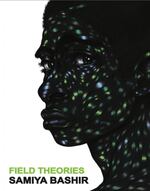
"When I saw this image, it was as if it was a fully articulated blues statement in a way that felt so exactly like what I was making that it blew me away," says Samiya Bashir of the image "Lonely Chamber" by Toyin Ojih Odutola that's now the cover of "Field Theories." "The flesh is lit by these blues and greens and yellows that are bursting like light, almost as if through a fractured black body. The fracture is not a furthering of oppression, but more like a cracking through or a release, sending back all that light that’s contained inside."
Courtesy of Nightboat Books
It’s easy to find poetry in science, from the ring of Latin names to the construction of an elegant theory. It’s a harder thing to find science in poetry. But that is the genesis of Portland poet Samiya Bashir’s book “Field Theories,” where poems titled after scientific principles like “Planck's Constant” and “Synchronous Rotation” plumb the space where theories collide with real life: from the back seat of a taxi to jazz clubs, early morning cigarettes, human fables, gun violence and Groucho Marx.
“I’ve worked on this book for six years at least, and what I did was walked around with glasses on that were glassed by quantum physics questions,” Bashir said. “That was the glass through which I saw everything.”
The collection recently won Bashir a literature fellowship from the Regional Arts and Culture Council, which recognized the Reed College creative writing professor as a consummate artist whose work can't be contained by the page. She regularly collaborates with dancers, filmmakers and actors to bring words alive in every way imaginable, from the series of videos she released online for "Field Theories" to the staged adaptation of Claudia Rankine's book "Citizen: an american lyric" she's co-producing at Reed College Nov. 3–11.
She will also read on Nov. 4 at 4 p.m. at Powell's on Hawthorne and appear on Nov. 11 at Wordstock on a panel about pop culture, science and mythology in poetry.

"I’ve worked on this book for six years at least," says Samiya Bashir, "and what I did was walked around with glasses on that were glassed by quantum physics questions."
Photo by Kenan Banks
Bashir traces her love of science to her childhood. Her father moved from Somalia to the United States to study and ultimately teach science and math (her mother taught English).
“I have a memory that will never leave me: We were in the classroom at the end of the school year, and me and my little sister were helping him clean out his classroom,” she recalled. “And he had all these equations on the board: It was for an algebra class. I was maybe 6 years old and said, ‘Dad, I though you taught math, why are all these letters on the board?’ And he sat me on the desk and explained algebra to me in a way that was crystal clear and wedded these two ideas for me.”
In “Field Theories,” Bashir transposes mathematical equations and scientific theories of idealized principles on the decidedly real and unideal world around her. In “Paleontology,” she writes: “I am a wooly mammoth stuffed into a cab. I bear the long silence of my own extinction through the rear view. My head on the back seat: horns akimbo: I melt dead air. Blame humans for the loss of large mammals like myself, a new study suggests.”
“Law of total probability” tells the story of a security guard showing off how safe his gun is only to have it go off, singeing Bashir’s clothing. The prose poem is littered with holes of white, as if bullets erased the text just as they do human lives.
But the science is most potent when it intersects with race in poems like “Blackbody curve,” “Blackbody radiation” and “We call it dark matter because it doesn’t interact with light.”
In physics, a blackbody is an idealized object that is perfectly absorbent. “So all the light, the heat, the radiation, whatever you shoot at it, it absorbs it while remaining constant,” Bashir said. “It doesn’t change its temperature, it doesn’t heat up, it doesn’t explode, it doesn’t get mad, hit back — it stays cool, which is exactly what I think is asked of us in our black bodies all day everyday.”
Whereas a whitebody is an object that is perfectly reflective.
“Those ideas, I almost don’t have to play with them,” Bashir said. “I feel like we’re living them, and they make such an obvious and clear metaphor, it’s almost as if it was created for the situation we’re living in.”
Bashir collaborated with the filmmaker Roland Dahwen Wu and the movement artist Keyon Gaskin to transform the poems into videos, remixing their words and her breath over videos of Gaskin dancing — sometimes as silhouette, sometimes unveiled — in settings ranging from a warehouse to a cosmic night sky. They filmed and released six videos once a month in the lead-up to the release of "Field Theories."
Watch "Field Theories" -six- below.
“Each remix really takes on the moment, and the moment is September of 2016 and October of 2016 and November of 2016,” Bashir said. “So the accident of art making comes together in wild ways sometimes. And as these videos happen, what we as a country and a people and a world are going through, it bleeds through the videos as well, just as it does in the poetry.”
Watch "Field Theories" -four- below.
